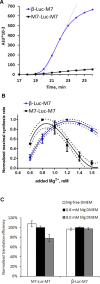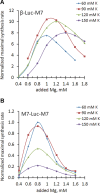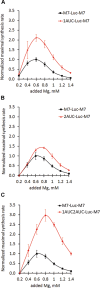Identification of a Mg2+-sensitive ORF in the 5'-leader of TRPM7 magnesium channel mRNA
- PMID: 25326319
- PMCID: PMC4227784
- DOI: 10.1093/nar/gku951
Identification of a Mg2+-sensitive ORF in the 5'-leader of TRPM7 magnesium channel mRNA
Abstract
TRPM7 is an essential and ubiquitous channel-kinase regulating cellular influx of Mg2+. Although TRPM7 mRNA is highly abundant, very small amount of the protein is detected in cells, suggesting post-transcriptional regulation of trpm7 gene expression. We found that TRPM7 mRNA 5'-leader contains two evolutionarily conserved upstream open reading frames that act together to drastically inhibit translation of the TRPM7 reading frame at high magnesium levels and ensure its optimal translation at low magnesium levels, when the activity of the channel-kinase is most required. The study provides the first example of magnesium channel synthesis being controlled by Mg2+ in higher eukaryotes.
© The Author(s) 2014. Published by Oxford University Press on behalf of Nucleic Acids Research.
Figures








Similar articles
-
Transient receptor potential melastatin 7 ion channels regulate magnesium homeostasis in vascular smooth muscle cells: role of angiotensin II.Circ Res. 2005 Feb 4;96(2):207-15. doi: 10.1161/01.RES.0000152967.88472.3e. Epub 2004 Dec 9. Circ Res. 2005. PMID: 15591230
-
Importance of melastatin-like transient receptor potential 7 and cations (magnesium, calcium) in human osteoblast-like cell proliferation.Cell Prolif. 2007 Dec;40(6):849-65. doi: 10.1111/j.1365-2184.2007.00476.x. Cell Prolif. 2007. PMID: 18021175 Free PMC article.
-
CNNM proteins selectively bind to the TRPM7 channel to stimulate divalent cation entry into cells.PLoS Biol. 2021 Dec 20;19(12):e3001496. doi: 10.1371/journal.pbio.3001496. eCollection 2021 Dec. PLoS Biol. 2021. PMID: 34928937 Free PMC article.
-
The Mg2+ and Mg(2+)-nucleotide-regulated channel-kinase TRPM7.Handb Exp Pharmacol. 2007;(179):313-28. doi: 10.1007/978-3-540-34891-7_19. Handb Exp Pharmacol. 2007. PMID: 17217066 Free PMC article. Review.
-
TRPM7, the Mg(2+) inhibited channel and kinase.Adv Exp Med Biol. 2011;704:173-83. doi: 10.1007/978-94-007-0265-3_9. Adv Exp Med Biol. 2011. PMID: 21290295 Review.
Cited by
-
PRL-1/2 phosphatases control TRPM7 magnesium-dependent function to regulate cellular bioenergetics.Proc Natl Acad Sci U S A. 2023 Apr 4;120(14):e2221083120. doi: 10.1073/pnas.2221083120. Epub 2023 Mar 27. Proc Natl Acad Sci U S A. 2023. PMID: 36972446 Free PMC article.
-
Conserved Upstream Open Reading Frame Nascent Peptides That Control Translation.Annu Rev Genet. 2020 Nov 23;54:237-264. doi: 10.1146/annurev-genet-112618-043822. Epub 2020 Sep 1. Annu Rev Genet. 2020. PMID: 32870728 Free PMC article. Review.
-
Reducing Ribosome Biosynthesis Promotes Translation during Low Mg2+ Stress.Mol Cell. 2016 Nov 3;64(3):480-492. doi: 10.1016/j.molcel.2016.05.008. Epub 2016 Oct 13. Mol Cell. 2016. PMID: 27746019 Free PMC article.
-
Four translation initiation pathways employed by the leaderless mRNA in eukaryotes.Sci Rep. 2016 Nov 28;6:37905. doi: 10.1038/srep37905. Sci Rep. 2016. PMID: 27892500 Free PMC article.
-
Magnesium-sensitive upstream ORF controls PRL phosphatase expression to mediate energy metabolism.Proc Natl Acad Sci U S A. 2019 Feb 19;116(8):2925-2934. doi: 10.1073/pnas.1815361116. Epub 2019 Feb 4. Proc Natl Acad Sci U S A. 2019. PMID: 30718434 Free PMC article.
References
-
- Nadler M.J., Hermosura M.C., Inabe K., Perraud A.L., Zhu Q., Stokes A.J., Kurosaki T., Kinet J.P., Penner R., Scharenberg A.M., et al. LTRPC7 is a Mg·ATP-regulated divalent cation channel required for cell viability. Nature. 2001;411:590–595. - PubMed
Publication types
MeSH terms
Substances
Grants and funding
LinkOut - more resources
Full Text Sources
Other Literature Sources
Miscellaneous

